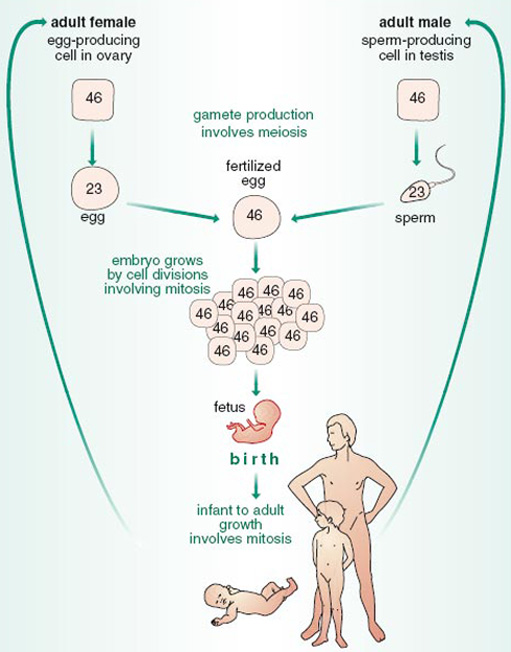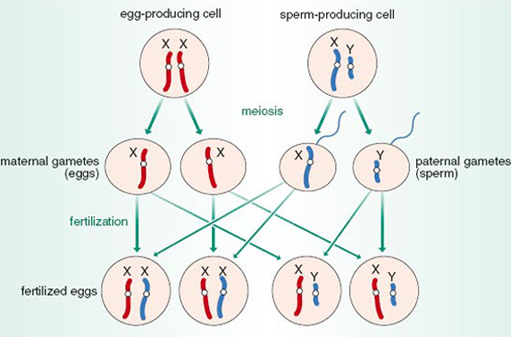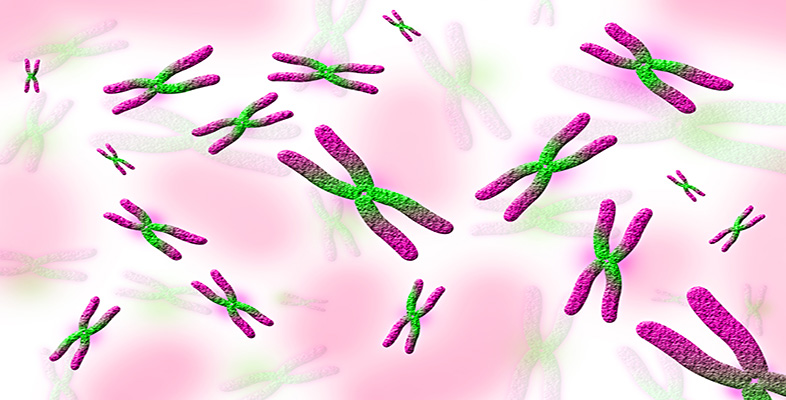1.2.3 The transmission of genetic material
The full complement of 46 chromosomes in the human genome, the diploid number, is restored at fertilization. As Figure 3.1 shows, all the somatic cells and cells in the testes and ovaries arise from the same fertilized egg by the process of mitosis; the cells all contain copies of the same genetic material (with some exceptions).

Activity 1
From Figure 3.1, do the gamete-producing cells have the same chromosome number as the somatic cells?
Answer
Yes; they have 46 chromosomes, the same number as somatic cells.
Each gamete-producing cell contains an identical copy of the genetic material in the somatic cells. Only the gametes contain half the chromosome number.
Now look at Figure 3.2, which illustrates the production of gametes in each parent and the possible combining of gametes at fertilization with reference to the sex chromosomes only. We have omitted all the other chromosomes to make it easier to follow the sex chromosomes. First, we consider the production of gametes, and in the next section we examine fertilization. Each one of the egg-producing cells in the ovaries of the female contains two X chromosomes, whereas the equivalent cells in the male each contain one X chromosome and one Y chromosome (top row of Figure 3.2). In the male, the X and Y chromosomes separate from each other during meiosis, the X chromosome to one sperm and the Y chromosome to another. Similarly, in the female, the two X chromosomes separate from one another, each one going into a different egg cell.
Activity 2
On the basis of the middle row of Figure 3.2, what are the proportions of X-bearing and Y-bearing gametes produced by the male?
Answer
Half of the gametes are X-bearing gametes and half are Y-bearing.
This answer can be expressed as a ratio in a number of ways; these are described in Box 3.1, Ratios.

Box 3.1 Ratios
Ratios are another way of expressing proportions. Ratios are usually written as two numbers separated by a colon (:). As the answer to the in-text question preceding this box shows, X- and Y-bearing gametes are produced by the male in equal numbers, so the ratio of X-bearing gametes to Y-bearing gametes is one to one, written as 1 : 1.
We are also interested in the proportion of the total number of gametes that are X-bearing gametes. The male produces two different types of gamete, of which one is X-bearing; so the ratio of X-bearing gametes to the total number of male gametes is 1 : 2.
Although not relevant in this case, it is important to note that ratios are usually simplified to the smallest whole numbers by dividing both sides by a common factor. For example, in a class of 4 boys and 8 girls, the ratio of boys to girls is 4 : 8, which is the same as 1 : 2, where both the numbers have been divided by 4.
You need to be careful about which ratio is being considered. Consider a practical example of a group of 20 people, 6 of whom have red hair and 14 of whom do not. The ratio of red-haired people to the total number of people is 6 : 20 (or 3 : 10). But now consider the ratio of red-haired people to non-red-haired people in the group: it is 6 : 14 (or 3 : 7).
SAQ 4
Suppose that 2 out of 10 people in the UK have blue eyes. What is the ratio of people with blue eyes to those who don't have blue eyes?
Answer
The ratio is 2 : 8 (or 1 : 4).
Did you fall into the trap and answer 2 : 10 (or 1 : 5)? This is the ratio of people who have blue eyes to the total number of people. If we had asked what is the ratio of people who don't have blue eyes to those who do, the answer would have been 8 : 2 (or 4 : 1). So always read the question carefully and make sure when expressing ratios that it is clear what each number refers to.
SAQ 5
Question 3.1, A class of children consists of 10 boys and 15 girls. What is the ratio of girls to boys?
Answer
The raion is 3:2 (i.e.15 girls to 10 boys); note that we simplified the numbers.
The behaviour of the sex chromosomes during meiosis is similar to that of all other pairs of chromosomes, that is the number is halved in each gamete. Thus the members of each of the 22 homologous pairs of autosomes in a gamete-producing cell also separate from each other during meiosis; one member of each chromosome pair enters each gamete. A consequence of the separation, or segregation, of members of homologous pairs of chromosomes (or the X and Y chromosomes) is that each gamete contains one member of each pair of autosomes and one sex chromosome (either X or Y).
We can now link the description of gamete production at the cellular level with the stages of meiosis. In males, meiosis begins at puberty and continues well into old age; each meiotic division takes just three hours. In contrast, in females the process of meiosis in an egg-producing cell begins before birth. But the halving of chromosomes during meiosis is halted within the egg-producing cell and is completed some time between puberty and menopause. Thus the process of meiosis and egg production in females is halted for many years before being completed. During a woman's reproductive life, one cell normally completes the meiotic division and gives rise to one egg during each menstrual cycle. The process of meiosis resulting in the production of an egg shortly after puberty has been halted for 10–15 years, and the process of meiosis resulting in the production of an egg just before menopause will have been halted for about 50 years!
